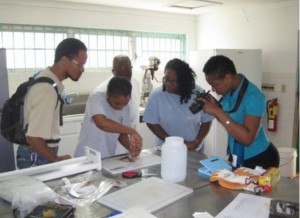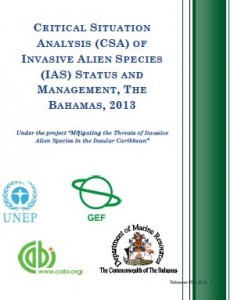 This Critical Situation Analysis (CSA) provides a comprehensive view of the occurrence, trends and distribution of Invasive Alien Species (IAS) in The Bahamas. It evaluates gaps in existing institutional, legislative and policy frameworks. It also describes the profile of The Bahamas and includes The Bahamas National Protected Area System. The CSA contains information from the National Invasive Species Strategy (NISS) that was originally completed in 2003 and updated in 2013.
This Critical Situation Analysis (CSA) provides a comprehensive view of the occurrence, trends and distribution of Invasive Alien Species (IAS) in The Bahamas. It evaluates gaps in existing institutional, legislative and policy frameworks. It also describes the profile of The Bahamas and includes The Bahamas National Protected Area System. The CSA contains information from the National Invasive Species Strategy (NISS) that was originally completed in 2003 and updated in 2013.
A total of 116 IAS have been identified for The Bahamas. They include plants, birds, terrestrial and aquatic species as well as microorganisms. Seven (7) plant and animal species have been targeted for eradication and 24 recommended for control. A management strategy has already been completed for the lionfish and a strategy is being developed for the newly identified cane toad, Rhinella marinus.
For many years The Bahamas has realized the importance of the prevention and control/eradication of IAS. As such many governmental agencies, departments and non- government organization have worked to develop programs to educate the public about IAS and to mitigate the effects of IAS. This CSA highlights many of those efforts through the islands of The Bahamas as well as within The Bahamas Protected Area System.
Also highlighted is the effort to develop a regional strategy to combat the issue of IAS, a regional initiative entitled Mitigating Threats of Invasive Species in the Insular Caribbean (MTIASIC) was implemented. The Project is funded by the Global Environment Facility through the Centre for Agricultural Bioscience International – Caribbean and Latin America (CABI-CLA) acting as the Regional Implementing Agency, overseeing project activities in The Bahamas the Dominican Republic Jamaica St. Lucia and Trinidad & Tobago. Each country identified a high priority IAS and developed early detection and rapid response, control, eradication or preventative measures where applicable. With the MTIASIC project, The Bahamas developed control measures for the red lionfish, Pterois volitans.
The project has five components: Development of National Invasive Species Strategies (NISS) but in the case of The Bahamas this CSA is being developed and the NISS updated, Caribbean-wide Cooperation and Regional IAS Strategy (CRISS), Information and Knowledge Generation, Management, and Dissemination, Prevention of IAS in Terrestrial, Freshwater and Marine Systems and Managing priority alien species invasions in pilot sites to ensure conservation and sustainable use of biodiversity.
Read Final Report on: Critical Situation Analysis (CSA) of Invasive Alien Species (PDF)
